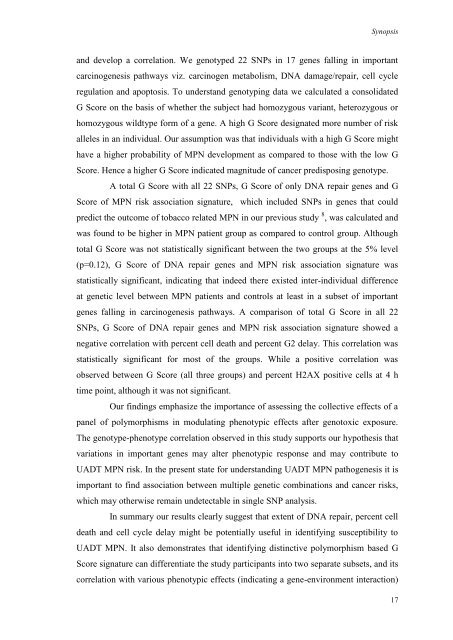LIFE09200604007 Tabish - Homi Bhabha National Institute
LIFE09200604007 Tabish - Homi Bhabha National Institute
LIFE09200604007 Tabish - Homi Bhabha National Institute
You also want an ePaper? Increase the reach of your titles
YUMPU automatically turns print PDFs into web optimized ePapers that Google loves.
Synopsis<br />
and develop a correlation. We genotyped 22 SNPs in 17 genes falling in important<br />
carcinogenesis pathways viz. carcinogen metabolism, DNA damage/repair, cell cycle<br />
regulation and apoptosis. To understand genotyping data we calculated a consolidated<br />
G Score on the basis of whether the subject had homozygous variant, heterozygous or<br />
homozygous wildtype form of a gene. A high G Score designated more number of risk<br />
alleles in an individual. Our assumption was that individuals with a high G Score might<br />
have a higher probability of MPN development as compared to those with the low G<br />
Score. Hence a higher G Score indicated magnitude of cancer predisposing genotype.<br />
A total G Score with all 22 SNPs, G Score of only DNA repair genes and G<br />
Score of MPN risk association signature, which included SNPs in genes that could<br />
predict the outcome of tobacco related MPN in our previous study 8 , was calculated and<br />
was found to be higher in MPN patient group as compared to control group. Although<br />
total G Score was not statistically significant between the two groups at the 5% level<br />
(p=0.12), G Score of DNA repair genes and MPN risk association signature was<br />
statistically significant, indicating that indeed there existed inter-individual difference<br />
at genetic level between MPN patients and controls at least in a subset of important<br />
genes falling in carcinogenesis pathways. A comparison of total G Score in all 22<br />
SNPs, G Score of DNA repair genes and MPN risk association signature showed a<br />
negative correlation with percent cell death and percent G2 delay. This correlation was<br />
statistically significant for most of the groups. While a positive correlation was<br />
observed between G Score (all three groups) and percent H2AX positive cells at 4 h<br />
time point, although it was not significant.<br />
Our findings emphasize the importance of assessing the collective effects of a<br />
panel of polymorphisms in modulating phenotypic effects after genotoxic exposure.<br />
The genotype-phenotype correlation observed in this study supports our hypothesis that<br />
variations in important genes may alter phenotypic response and may contribute to<br />
UADT MPN risk. In the present state for understanding UADT MPN pathogenesis it is<br />
important to find association between multiple genetic combinations and cancer risks,<br />
which may otherwise remain undetectable in single SNP analysis.<br />
In summary our results clearly suggest that extent of DNA repair, percent cell<br />
death and cell cycle delay might be potentially useful in identifying susceptibility to<br />
UADT MPN. It also demonstrates that identifying distinctive polymorphism based G<br />
Score signature can differentiate the study participants into two separate subsets, and its<br />
correlation with various phenotypic effects (indicating a gene-environment interaction)<br />
17

















